Alessandro Magnasco
Paintings
Jacob Wrestling With The Angel


The Catechism in the Cathedral of Milan
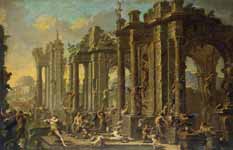
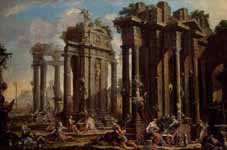
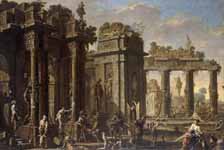
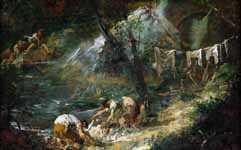
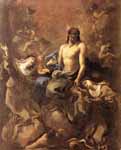
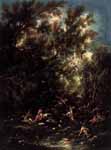

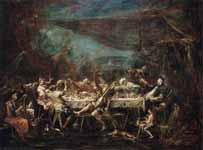

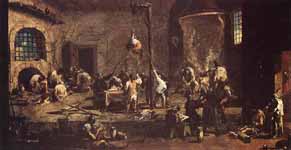

Joseph Interprets the Dreams of the Pharaoh's Servants Whilst in Jail
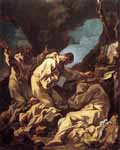
Three Camaldolese Monks in Ecstatic Prayer
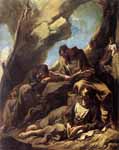
Three Camaldolese Monks in Meditative Prayer
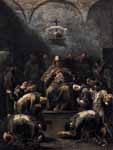


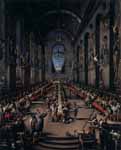
The Observant Friars in the Refectory
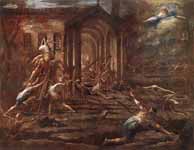
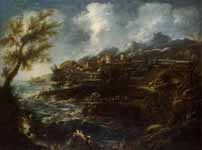



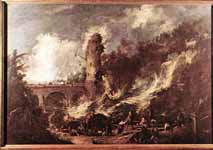
Drawings
A Quaker Sermon
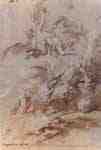
Fine Art Prints | Greeting Cards | iPhone Cases | Tote Bags | Clothing | Lifestyle | Beach ...
Alessandro Magnasco (February 4, 1667 – March 12, 1749), also known as il Lissandrino, was an Italian late-Baroque painter active mostly in Milan and Genoa. He is best known for stylized, fantastic, often phantasmagoric genre or landscape scenes.
Biography
Born in Genoa to a minor artist, Stefano Magnasco, he apprenticed with Valerio Castello, and finally with Filippo Abbiati (1640–1715) in Milan. Except for 1703–09 (or 1709–11)[1] when working in Florence for the Grand Duke Cosimo III, Magnasco labored in Milan until 1735, when he returned to his native Genoa. Magnasco often collaborated with placing figures in the landscapes of Tavella and the ruins of Clemente Spera in Milan.
Mature style
After 1710, Magnasco excelled in producing small, hypochromatic canvases with eerie and gloomy landscapes and ruins, or crowded interiors peopled with small, often lambent and cartoonishly elongated characters. The people in his paintings were often nearly liquefacted beggars dressed in tatters, rendered in flickering, nervous brushstrokes. Often they deal with unusual subjects such as synagogue services, Quaker meetings, robbers' gatherings, catastrophes, and interrogations by the Inquisition. His sentiments regarding these subjects are generally unclear.
A century later he would be described as a romantic painter: who painted with candid touches, and ingenious expressiveness, little figures in Gothic churches; or in solitude, hermits and monks; or scoundrels assembled in town squares; soldiers in barracks.[2] The noted art historian and critic Luigi Lanzi described him as the Cerquozzi of his school; thereby signaling him into the circle of followers of the Bamboccianti. He indicates that Magnasco had figures scarcely more than a span large ... painted with humor and delight, but not as if this effect had been the intention of the painter. Lanzi indicates these eccentric pieces were favored by the Grand Duke Giovanni Gastone Medici of Florence.[3] Magnasco also found contemporary patronage for his work among prominent families and collectors of Milan, for example the Arese and Casnedi families of Milan.[4] This series of patrons underscores the fact that Magnasco was more esteemed by outsiders than by his fellow Genoese; as Lanzi noted, his bold touch, though joined to a noble conception and to correct drawing, did not attract in Genoa, because it is far removed from the finish and union of tints which (Genoese) masters followed.[5] In the twentieth century, Rudolf Wittkower derided him as solitary, tense, strange, mystic, ecstatic, grotesque, and out of touch with the triumphal course of the Venetian school from 1710 onward.[1]
Origins of his style
The influences on his work are obscure. Some suspect the influence of the loose painterly style of his Venetian contemporary Sebastiano Ricci (1659–1734), the Genoese Domenico Piola (1627–1703) and Gregorio de Ferrari, although the most prominent of the three, Ricci, painted in a more monumental and mythic style, and these artists may in fact have been influenced by Magnasco. Magnasco was likely influenced by Milanese il Morazzone (1573–1626) in the emotional quality of his work. Some of his canvases (see ill. (q.)) recall Salvatore Rosa's romantic sea-lashed landscapes, and his affinity for paintings of brigands. The diminutive scale of Magnasco's figures relative to the landscape is comparable to Claude Lorrain's more airy depictions. While his use of figures of ragged beggars has been compared with Giuseppe Maria Crespi's genre style, Crespi's figures are larger, more distinct, and individual, and it is possible that Crespi himself may have influenced Magnasco. Others point to the influences of late Baroque Italian genre painters, the Roman Bamboccianti, and in his exotic scenography, the well-disseminated engravings of the Frenchman Callot.
Legacy of his style
Magnasco's style is strikingly original and transcends the tired, academic Baroque that epitomized much of contemporary Genoese art. Ultimately, his work may have influenced Marco Ricci, Giuseppe Bazzani, Francesco Maffei, and the famed painters de tocco (by touch) Gianantonio and Francesco Guardi in Venice. But for these Rococo painters, the loose brush became a tool for frothy landscapes, capricious historical scenography, and decorative frolics, while for Magnasco, it seemed to have entrapped his reality in a gloomy cobweb.
His depictions of torture in The Inquisition (or perhaps named Interrogations in a Jail) and of other lowpoints of humanity seem to impart a modern perspicacity to his social vision, recalling that expressed by Spanish Goya in his 19th century etchings. And yet, as Wittkower notes, it remains unsolved "how much quietism or criticism or farce went into the making of his pictures".[1] It is unknown what his true sentiments about Jews and Quakers were. Were his paintings derogatory of those congregations, or do they express some intellectual fascination with what were considered exotic elements in the Italian mainstream? No clear documentary evidence exists. Magnasco, as an outsider, would have been excluded from a synagogue or Quaker service, and the non-individualized cartoons which populate those canvases can hardly be expected to garner personal sympathy. Elsewhere Magnasco painted miracles, including one canvas in which the Virgin Mary summons avenging skeletons out of their graves to fend off church-robbers. What insight one can garner about Jews or Quakers from Magnasco's paintings, like Macbeth's dialogue in the fog-ridden fen with the cauldron-stirring witches, is not clearly intelligible or in focus, being part-prescient and part ghoulishly confused.
| Painting | Dates | Site | |
|---|---|---|---|
| Gathering of Quakers | 1695 | Uffizi, Florence | |
| Theodosius Repulsed from Church by St. Ambrose | 1700-10 | Art Institute of Chicago | |
| Christ and Samaritan Woman | 1705-10 | Getty Museum, Los Angeles | |
| Noli Me Tangere | 1705-10 | ibid | |
| The Hunting Scene | 1710 | Wadsworth Atheneum | |
| Muletrain and Castle | 1710 | Louvre | |
| Bacchanalian Scene | 1710s | Hermitage Museum | |
| Halt of the Brigands | 1710s | ibid | |
| The Inquisition or Interrogations in a Jail | 1710-20 | Kunsthistorisches Museum | |
| The Temptation of Saint Anthony | 1710-20 | Louvre | |
| Landscape with Shepherds | c. 1710-30 | São Paulo Museum of Art, São Paulo | |
| Pulcinella singing with Family and Lute Player | 1710-35 | Columbia Museum of Art, Columbia | |
| Three Camaldolite Monks at Prayer | 1713-14 | Rijksmuseum | |
| Three Capuchin Friars Meditating in their Hermitage | 1713-14 | ibid | |
| Christ Adored by Two Nuns | c. 1715 | Accademia | |
| The Sack of a City | 1719-25 | Sibiu, Muzeul Brukenthal, Abbey of Seitenstetten | |
| Satire of Nobleman in Misery | 1719-25 | Detroit Institute of Arts | |
| Bacchanale | 1720-30 | The Getty Center in Los Angeles | |
| Triumph of Venus | 1720-30 | ibid | |
| Interior with Monks | 1725 | Norton Simon Museum | |
| Gamblers, Soldiers and Vagabonds | 1720-30 | Staatsgalerie Stuttgart | |
| Supper of Pulcinella & Colombina | 1725-30 | North Carolina Museum of Art, Raleigh | |
| The Synagogue | 1725-30 | Cleveland Museum of Art | |
| Consecration of a Franciscan Friar | c. 1730 | El Paso Museum of Art, El Paso | |
| Burial of a Franciscan Friar | c. 1730 | El Paso Museum of Art, El Paso | |
| Sacrilegious Robbery | 1731 | intended for church of Siziano, now in Quadreria Arcivescovile, Milan | |
| Exorcism of the Waves | after 1735 | Rochester, New York | |
| The Observant Friars in the Refectory | 1736-37 | Museo Civico, Bassano del Grappa | |
| Figures Before a Stormy Sea | ca. 1740 | Honolulu Museum of Art | |
| The Entrance to a Hospital | Muzeul des Arta, Bucharest | ||
| Landscape with Camaldolese friars | Museo Giannetino Luxora, Genoa | ||
| The Marriage Banquet | Louvre | ||
| Praying Monks | Museum voor Schone Kunsten, Ghent | ||
| Reception in a Garden | Palazzo Bianco, Genoa | ||
| Seashore | Hermitage Museum | ||
| Supper at Emmaus | Convent S. Francesco in Albaro, Genoa | ||
| The Tame Magpie | Metropolitan Museum | ||
| Two Hermits in Forest | Louvre | ||
| Untitled |
Notes
Wittkower, 1993, p. 478
Dizionario geografico-storico-statistico-commerciale degli stati del Re di Sardegna, Volume 7, by Goffredo Casalis, Turin (1840), page 726:
potrebbe chiamarsi pittore romantico: dipingeva a tocchi franchi, e con isprezzatura ingegnosa, figure piccole in chiese d'architettura gotica, o in solitudini, romiti, cappuccini; ovvero mariuoli sulle piazze, soldati ne’quartieri
Lanzi, Luigi (1847). Thomas Roscoe (translator), ed. History of Painting in Italy; From the Period of the Revival of the Fine Arts to the End of the Eighteenth Century III. London; Original from Oxford University, Digitized January, 2007: Henry G. Bohn. p. 287.
Spike, 1986, p. 87
Lanzi, page 287.
References
Raffaello Soprani, Carlo Giuseppe Ratti (a cura di), Vite de Pittori, Scultori ed Architetti Genovesi; In questa seconda Edizione rivedute, accresciute ed arricchite di note da Carlo Giuseppe Ratti Tomo Primo, Stamperia Casamara, dalle Cinque Lampadi, con licenza de superiori, Genova, 1769. Pagine 155-164
Herman Voss, A Re-discovered Picture by Alessandro Magnasco, in "The Burlighton Magazine", LXXI, pp. 171–177. London 1937
A Loan Exhibition of Paintings by Alessandro Magnasco, exhibition catalogue, Durlacher Bros, New York
Golden Gate International Exhibition, California Palace of Fine Arts, San Francisco, 1940
Maria Pospisil, Magnasco. Firenze 1944
Benno Geiger, Magnasco. Bergamo 1949
Antonio Morassi, Mostra del Magnasco, exhibition catalogue, Bergamo 1949
Renato Roli, Alessandro Magnasco, Milano 1964
V.Magnoni, Alessandro Magnasco, Roma 1965
Alessandro Magnasco, exhibition catalogue, Louisville-Ann Arbor, 1967
Fausta Franchini Guelfi, Alessandro Magnasco. Genova 1977
Spike, John T. (1986). Centro Di, Kimball Museum of Art, Fort Worth, Texas, USA, ed. Giuseppe Maria Crespi and the Emergence of Genre Painting in Italy. p. 87.
Fausta Franchini Guelfi, Alessandro Magnasco. Soncino (Cr) 1991
Wittkower, Rudolf (1993). Art and Architecture Italy, 1600-1750. Penguin Books, Pelican History of Art. p. 478.
L.Muti - D. De Sarno Prignano, Magnasco. Faenza 1994
Alessandro Magnasco 1667-1749. Exhibition catalogue. Milano 1996
Jane Turner (a cura di), The Dictionary of Art. 20, pp. 95–96. New York, Grove, 1996. ISBN 1-884446-00-0
----
Fine Art Prints | Greeting Cards | Phone Cases | Lifestyle | Face Masks | Men's , Women' Apparel | Home Decor | jigsaw puzzles | Notebooks | Tapestries | ...
----
Artist
A - B - C - D - E - F - G - H - I - J - K - L - M -
N - O - P - Q - R - S - T - U - V - W - X - Y - Z
Retrieved from "http://en.wikipedia.org/"
All text is available under the terms of the GNU Free Documentation License






